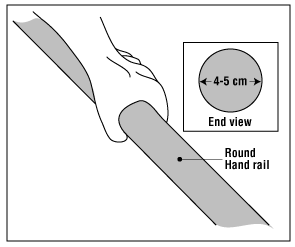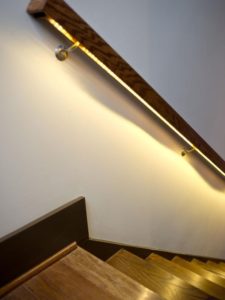First off, let’s get one thing straight.
Stairs are not accessible.
The best way to make stairs accessible would be to not have any stairs at all.
Eliminating stairs from the exterior of your house up to your front entry is more easily achievable than eliminating interior stairs up to a second floor.
That being said, I know a number of elderly people who’ve told me that their stairs are the only exercise they get. Which leads me to the conclusion that the ideal situation would be to have an elevator as well as stairs on the interior of your home (remember that we never want stairs to the entry of our home).
Features of Safer Stairs
Handrails
- Required on at least one side of every staircase but having them on both sides is best. How would you use a handrail that was only on one side of the stairs if you have an injury to one arm?
- The proper height is between 34-38in/86-96.5cm. This should allow you to use the handrail comfortably when your arm is slightly bent at the elbow.
-
Extend them horizontally past the top and bottom of your stairs for added safety as they will act as an indicator of a level change. This is especially useful for people with low vision.
- Use a round handrail of about 1 ¾ in/4.5cm rather than a rectangular shape. You achieve a more powerful grip on a round one than the pinch grip you are forced to adopt on a rectangular shape. One of the purposes of a handrail is that it must be able to be grasped quickly, easily and firmly should you start to lose your balance.
- They should be installed as a single continuous rail that you can run your hand along as you travel.
- Make sure to have a minimum hand/knuckle clearance from the wall of 1.5in/4cm and a maximum projection over the stairs of 4.5in/ 11cm.
Steps
-
Ensure you have a non-slip textured surface on the stair tread or at least on the leading edge. This is achievable with carpet treads, rubber, metal and non-slip paint or adhesive strips. Carpet treads are a great option as they offer a large non-slip surface, can be placed on your tread to create a contrasting front edge for safety, are available in a variety of colors to suite any interior, and they still allow you to enjoy your beautiful wood stairs.
- Have a contrasting nosing on each stair for better visibility. This is achievable with paint, adhesive strips or using darker or lighter wood tones. TIP: This is especially useful at the top of any run of stairs.
- Be sure your steps are uniform from top to bottom. Even a slight change in size is a tripping hazard.
- Riser height should be between 5-7in/12.5-18cm.
- Step width (from left to right) should be minimum 36in/90cm.
- Tread depth should be 10-14in/25.5-35.5cm.
- Keep your stairs free of clutter. Always.
- Use a matt finish on treads to avoid glare.
Lighting
-
Ensure you have bright overhead lighting that illuminates your whole staircase.
- Install light switches at the top and bottom of the stairs.
- Use low wall lights adjacent to stair treads to help eliminate shadows. TIP: Put these on a motion sensor to turn on automatically.
- Install LED strip lighting under your handrail for better illumination and an interesting effect.
Stair alternatives
- Install an elevator near your stairs.
- Add a stair lift into your stairway.
Action Plan
According to the Government of Canada’s public-health web page, seniors are more at risk for falling on stairs than younger adults, and more likely to suffer severe injuries. In fact, seniors 65 plus account for 70% of the deaths resulting from stair accidents.
That’s reason enough in our opinion to get serious about improving the safety of your stairs.
You might be interested in reading our 2 part posting about ramps if you can’t eliminate stairs to the entry to your home.




